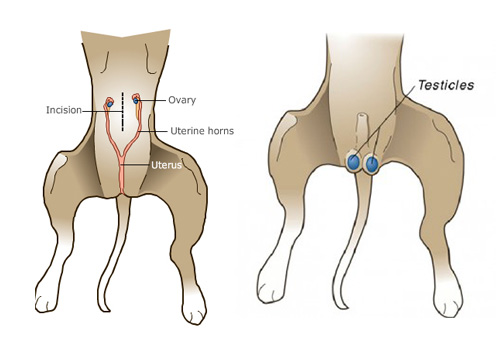Laurie's Blogs.
Jul 2024
Early Spay and Neuter Risks, but Now With Information About 5 More Breeds

I reported on a study a few years ago, about the associated risk factors for early spay or neuter. It was a paper that covered 35 different breeds. Well, that research has continued and expanded even further! Check out this paper (and ones from the past) to help you or your clients decide what is right for their pet.
Hart LA, Thigpen AP, Hart BL, Willits NH, Lee M, Babchuk MM, Lee J, Ho M, Clarkson ST, Chou JW. Assisting decision-making on age of neutering for German Short/Wirehaired Pointer, Mastiff, Newfoundland, Rhodesian Ridgeback, Siberian Husky: associated joint disorders, cancers, and urinary incontinence. Front Vet Sci. 2024 Apr 12;11:1322276.
https://pubmed.ncbi.nlm.nih.gov/38681849/ (open access journal)
The breeds were: German Short/Wirehaired Pointer, Mastiff, Newfoundland, Rhodesian Ridgeback, and Siberian Husky. Major differences among breeds appeared in vulnerability to joint disorders and cancers with early neutering: male and female Pointer breeds had elevated joint disorders and increased cancers; male Mastiff breeds had increased CCL and LSA and females had non-significant elevated CCL risks; female Newfoundland breeds had heightened risks for joint disorders and males had non-significant elevated risks; female Ridgeback breeds had heightened MCT with very early neutering; and Siberian Huskies showed no significant effects on joint disorders or cancers, but female breeds showed a non-significant but elevated CCL.
In looking at what has been researched thus far, there appears to be risks to early spay or neuter related to breed-, gender-, and body-size specific and related to neutering age.
And just as a reminder to source the previous paper with the previous information:
Hart BL, Hart LA, Thigpen AP, Willits NH. Assisting Decision-Making on Age of Neutering for 35 Breeds of Dogs: Associated Joint Disorders, Cancers, and Urinary Incontinence. Front Vet Sci. 2020 Jul 7;7:388.
https://pubmed.ncbi.nlm.nih.gov/32733924/ (open access journal)
The joint disorders include hip dysplasia, cranial cruciate ligament tear or rupture, and elbow dysplasia. The cancers include lymphoma, mast cell tumor, hemangiosarcoma, and osteosarcoma. The final list of 35 (including three varieties of Poodle) represented in the present study are, alphabetically, the: Australian Cattle Dog, Australian Shepherd, Beagle, Bernese Mountain Dog, Border Collie, Boston Terrier, Boxer, Bulldog, Cavalier King Charles Spaniel, Chihuahua, Cocker Spaniel, Collie, Corgi (Pembroke and Cardigan combined), Dachshund, Doberman Pinscher, English Springer Spaniel, German Shepherd Dog, Golden Retriever, Great Dane, Irish Wolfhound, Jack Russell Terrier, Labrador Retriever, Maltese, Miniature Schnauzer, Pomeranian, Poodle-Miniature, Poodle-Standard, Poodle-Toy, Pug, Rottweiler, Saint Bernard, Shetland Sheepdog, Shih Tzu, West Highland White Terrier, and Yorkshire Terrier.
I wrote about this article and some related articles in these two blogs from the past:
July 11, 2020 – When to Spay or Neuter?
https://www.fourleg.com/Search-Results?t=b&id=469
May 21, 2022 – Spaying and Neutering Decision Making
https://www.fourleg.com/Search-Results?t=b&id=567
Despite this information being out and freely available, It doesn’t seem to have trickled down to common knowledge just yet. So, I think it is worthwhile even for rehab practitioners to engage puppy owner-clients towards learning more early spay and neuter and to empower them with knowledge and tools to make an informed decision.
Now you know!
Cheers,
Laurie


